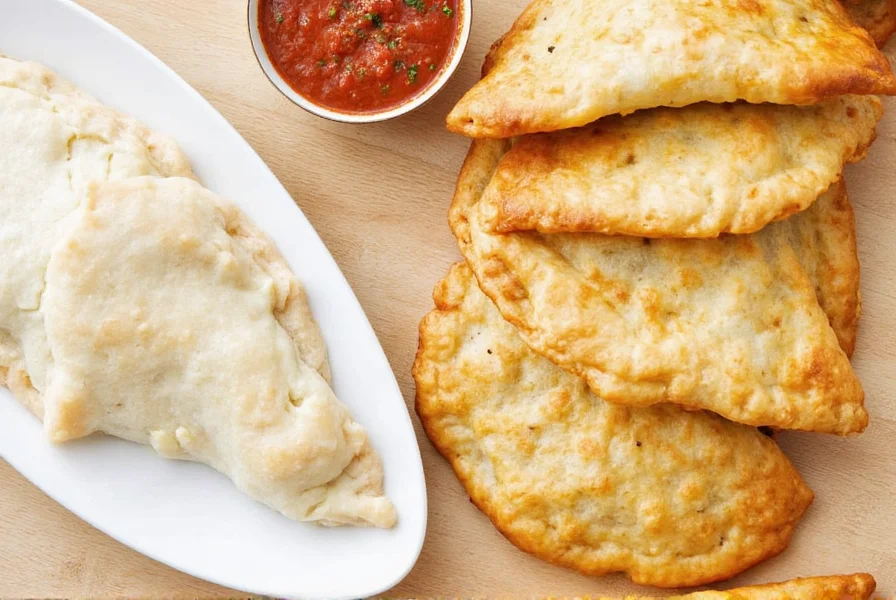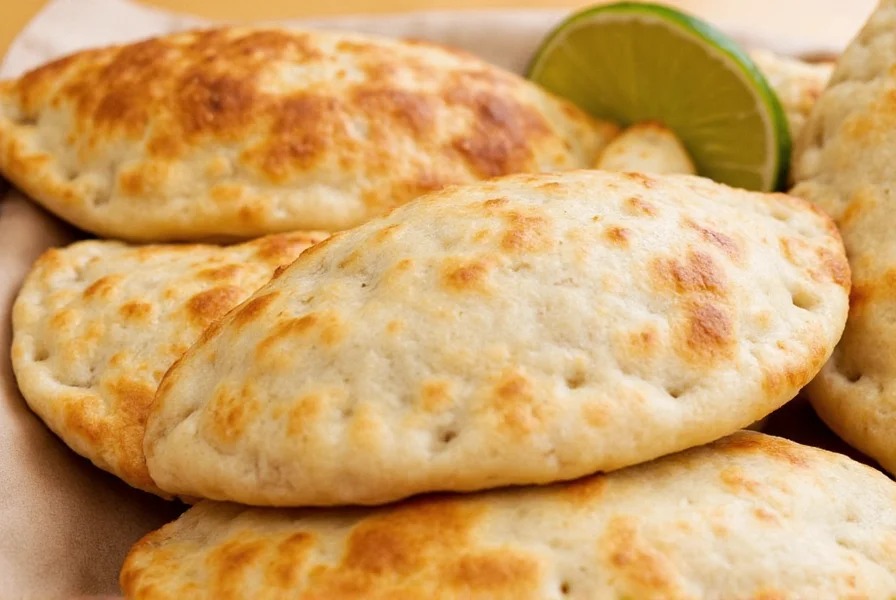Looking for the best spices for empanadas? This guide covers the 5 essential spices for authentic global empanada flavors, with detailed profiles, practical tips, and perfect beverage pairings.
Whether you're a culinary pro or just starting out in the kitchen, discover how to transform your empanadas from simple snacks to international sensation with expert spice knowledge. We'll explore the global spice traditions that define empanada flavors across cultures, offer practical tips for home cooks, and even break down spice profiles in easy-to-compare tables.
Table of Contents
- What Are Empanadas?
- Global Spice Traditions in Empanadas
- Top 5 Spices That Define Regional Empanada Flavors
- Buying Guide: How to Choose the Best Spices for Empanadas
- Pro Tips for Spicing Up Your Empanada Dough and Fillings
- Frequently Asked Questions
- Empanada & Beverage Pairing: Spice Meets Sip
- Final Thoughts: The World in One Bite
What Are Empanadas?
At their core, empanadas are stuffed pastries made with dough and filled with various ingredients—meat, cheese, vegetables, seafood, and more. Originating in Spain and later adapted by Latin American, Filipino, Portuguese, and North African cuisines, these hand-held delights have become a global comfort food staple.
The secret to elevating empanadas from basic to brilliant lies not just in what's inside—but how you season it. Enter spices.
Global Spice Traditions in Empanadas

Each country that has embraced empanadas has also developed its own signature spice blend. From smoky paprika in Argentina to warming cumin in India, let's take a tour of flavor profiles around the globe:
| Country | Signature Empanada Style | Key Spices Used |
|---|---|---|
| Argentina | Beef-filled, oven-baked | Paprika, oregano, black pepper |
| Mexico | Meat or cheese, fried or baked | Chili powder, cumin, garlic |
| Philippines | Sweet and savory fillings | Cinnamon, nutmeg, ginger |
| Turkey | Meat-filled, flaky pastry | Cumin, allspice, parsley |
| India | Vegetable samosa-style | Garam masala, turmeric, coriander |
Top 5 Spices That Define Regional Empanada Flavors
- Paprika – Smoky or sweet, paprika gives Spanish and Argentinian empanadas their earthy warmth. Recommended usage: 1-2 teaspoons per pound of meat filling for savory empanadas, or 1/2 teaspoon for dough infusion.
- Cumin – This aromatic seed is a key player in Mexican, Indian, and Middle Eastern versions, adding depth and heat. Recommended usage: 1 teaspoon per pound of filling for Mexican-style, or 1/2 teaspoon for Indian-style empanadas.
- Oregano – Especially popular in South American styles, it brings a rustic herbal note to meat fillings. Recommended usage: 1 teaspoon dried oregano per pound of meat filling, or 1 tablespoon fresh for Mediterranean-style empanadas.
- Garam Masala – Found in Indian empanadas (or samosas), this complex blend enhances both vegetarian and meat fillings. Recommended usage: 1-2 teaspoons per cup of filling for authentic Indian flavor.
- Cinnamon & Nutmeg – Common in Filipino and some Caribbean styles, especially for sweet or dessert empanadas. Recommended usage: 1/2 teaspoon cinnamon and 1/4 teaspoon nutmeg per cup of sweet filling for dessert empanadas.
Buying Guide: How to Choose the Best Spices for Empanadas

If you're serious about mastering empanada seasoning, here's how to pick the right spices for the job:
| Spice | Best For | Flavor Profile | Recommended Brand | Use Case |
|---|---|---|---|---|
| Paprika (smoked) | Spanish, Argentinian, Chilean empanadas | Earthy, slightly sweet, smoky | La Flor | Ground beef, potato, chicken fillings (use 1-2 tsp per lb of filling) |
| Cumin | Mexican, Indian, Turkish | Earthy, warm, nutty | McCormick | Bean, lamb, ground meat fillings (use 1 tsp per lb for Mexican, 1/2 tsp for Indian) |
| Oregano (dried Greek or Mexican) | South American, Mediterranean | Herbal, peppery | Primo Taglio | Tomato-based sauces, beef, egg fillings (use 1 tsp dried or 1 tbsp fresh per lb) |
| Garam Masala | Indian, fusion | Complex, spicy-sweet | MDH | Potato, chickpea, spinach fillings (use 1-2 tsp per cup of filling) |
| Cinnamon (ground or stick) | Filipino, Caribbean | Warm, sweet, woody | Burlap & Barrel | Dessert empanadas, banana, mango fillings (use 1/2 tsp per cup of sweet filling) |
Where to Buy:
- Local Markets: Great for fresh spices and blends, especially in specialty stores. Look for spices in small quantities to ensure freshness.
- Online Retailers: Amazon, Penzeys, and specialty spice shops offer curated global spice mixes. Check reviews for quality assurance.
- Whole Spices vs. Ground: Whole spices last longer and can be toasted for enhanced flavor. Grind them yourself for fresher results. For best flavor, buy whole cumin seeds and grind them just before use.
Pro Tips for Spicing Up Your Empanada Dough and Fillings

Want to impress your friends with restaurant-level empanadas at home? Here are our favorite pro tips to spice things up:
- Toasting Spices: Toast whole spices like cumin seeds or peppercorns before grinding them to unlock deeper flavor. For best results, toast 1/4 cup of whole spices in a dry pan over medium heat for 2-3 minutes until fragrant, then grind immediately.
- Dough Infusion: Add a pinch of smoked paprika or ground cinnamon to your dough for subtle warmth in every bite. For savory dough: add 1/4 tsp smoked paprika per cup of flour. For sweet dough: add 1/4 tsp cinnamon per cup of flour.
- Layering Flavor: Mix dry spices into your filling early so they infuse throughout the dish while marinating. For beef empanadas, combine 1 tsp smoked paprika, 1/2 tsp cumin, and 1 tsp oregano with the meat 30 minutes before cooking.
- Balance Heat & Sweetness: Use chili flakes or Aleppo pepper for heat, and pair with a touch of brown sugar or honey in dessert-style empanadas. For Mexican-style chicken empanadas, balance 1/2 tsp cayenne with 1 tsp honey in the filling.
- Rest Your Filling: Let your seasoned filling rest in the fridge for 30 minutes to an hour—this allows the flavors to meld beautifully. For vegetarian fillings, rest for at least 1 hour to allow spices to fully penetrate vegetables.
Frequently Asked Questions
What's the correct spelling: empanadias or empanadas?
The correct spelling is "empanadas" (not empanadias). This Spanish word comes from the verb "empanar," meaning "to wrap or coat in bread." The misspelling "empanadias" is common among beginners, but knowing the proper term will help you find authentic recipes and ingredients.
Can I make empanada dough without special spices?
Absolutely! Traditional empanada dough is quite simple (flour, fat, water, salt), but adding spices takes it to the next level. For beginners, start with basic dough and focus on spicing your fillings first. As you gain confidence, try adding subtle spice infusions to your dough—like 1/4 teaspoon of smoked paprika for savory versions or a pinch of cinnamon for sweet empanadas.
What's the best way to prevent empanadas from getting soggy?
To prevent sogginess: 1) Make sure your fillings are completely cooled before assembling, 2) Avoid overly wet ingredients (cook down vegetables to remove excess moisture), 3) Create a flavor barrier by mixing a tablespoon of breadcrumbs or cornstarch into your filling, and 4) Seal edges tightly to prevent filling leakage during cooking. Proper spice distribution also helps absorb excess moisture while enhancing flavor.
Can I substitute spices if I don't have the exact ones listed?
Yes! Here are some smart substitutions: Paprika can be replaced with a pinch of cayenne plus a touch of sweet pepper; Garam masala can be approximated with equal parts cinnamon, cardamom, and cloves; Cumin can be swapped with coriander (though it's milder). Remember that substitutions change the authentic regional profile but can still yield delicious results. Always start with less spice than you think you need—you can always add more later.
How do I know when empanadas are fully cooked?
Empanadas are done when they're golden brown (about 375-400°F for baking or 350°F for frying). For baked empanadas, this typically takes 20-25 minutes. The dough should feel firm but not hard when tapped. If using a thermometer, the internal temperature should reach 165°F for meat fillings. Proper spice-to-dough ratio ensures flavors penetrate completely during cooking time.
Can I freeze empanadas before or after cooking?
Both methods work! For best results: Freeze uncooked empanadas on a baking sheet until firm (about 1 hour), then transfer to freezer bags. Cook from frozen, adding 5-10 minutes to baking time. For cooked empanadas, let them cool completely before freezing. Reheat in a 350°F oven until heated through (about 15 minutes). Spices maintain their integrity well during freezing, though fresh herbs are best added after reheating.
What spices work best for vegetarian empanadas?
For vegetarian empanadas, try these spice combinations: - South American style: 1 tsp smoked paprika, 1/2 tsp cumin, 1/2 tsp oregano - Indian style: 1 tsp garam masala, 1/2 tsp turmeric, 1/4 tsp ginger - Mediterranean style: 1 tsp za'atar, 1/2 tsp sumac, 1/4 tsp sumac - Mexican style: 1 tsp chili powder, 1/2 tsp cumin, 1/4 tsp garlic powder These blends add depth to vegetable fillings without overpowering the natural flavors.
How do I make my own empanada spice blend?
Creating your own spice blend is simple! Here's a basic recipe for a versatile empanada spice mix: - 2 tbsp smoked paprika - 1 tbsp cumin - 1 tbsp oregano - 1 tsp garlic powder - 1/2 tsp black pepper - 1/4 tsp cayenne (optional for heat) Mix all ingredients thoroughly and store in an airtight container. Use 1-2 teaspoons per pound of filling for savory empanadas. For sweet empanadas, replace cayenne with 1/2 tsp cinnamon and 1/4 tsp nutmeg.
Empanada & Beverage Pairing: Spice Meets Sip
Don't forget the drinks! The right beverage can highlight or mellow out the spices in your empanadas:
| Empanada Type | Spice Level | Recommended Drink | Why It Works |
|---|---|---|---|
| Argentinian Beef | Mild-Medium | Malbec Wine | Rich red wine complements smoky paprika and beef |
| Mexican Chicken | Medium-Hot | Margarita | Citrus cuts through heat; salt enhances spice notes |
| Filipino Ube | Sweet & Mild | Thai Iced Tea | Creamy sweetness mirrors tropical flavors |
| Indian Vegetable | Spicy & Complex | Lassi (Mango or Plain) | Cooling yogurt balances fiery spices |
| Turkish Lamb | Medium-Aromatic | Mint Tea | Refreshing mint offsets bold spices |
| Vegetarian South American | Mild | Citrus Soda | Bright acidity complements smoky paprika in vegetable fillings |
| Caribbean Sweet | Sweet | Rum Punch | Rum's sweetness enhances cinnamon and tropical fruit flavors |
Final Thoughts: The World in One Bite

From the bustling street carts of Buenos Aires to the family kitchens of Manila, empanadas tell stories of migration, adaptation, and above all—flavor. By exploring the spices behind each region's signature style, you're not just making a snack—you're creating a cultural experience.
So go ahead, experiment with garam masala in your next batch, toast some cumin for a richer taco-inspired twist, or sprinkle cinnamon into your dough for a sweet surprise. After all, life is too short for bland empanadas.
Now get out there, roll up your sleeves, and start spicing!











 浙公网安备
33010002000092号
浙公网安备
33010002000092号 浙B2-20120091-4
浙B2-20120091-4